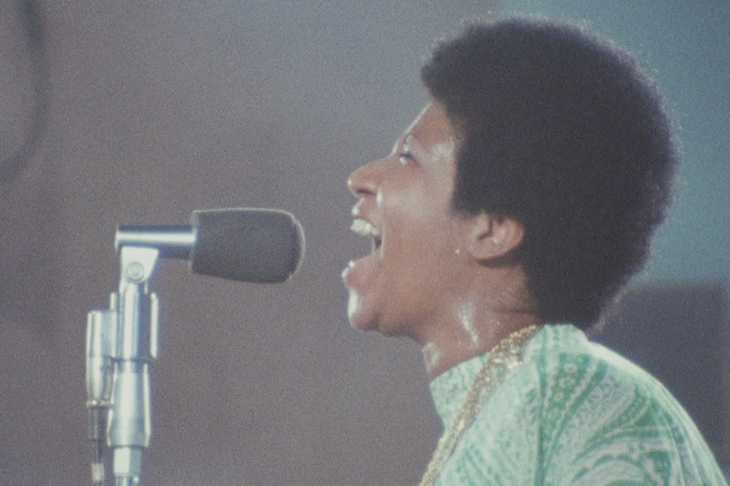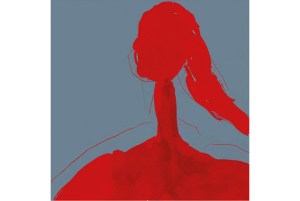Aretha Franklin recorded her best album, the live Gospel performance Amazing Grace, over two nights in January 1972 at the New Temple Missionary Baptist Church in Watts, Los Angeles. The Queen of Soul had crossed over, and perhaps too far, with the Live at the Fillmore West album, a play for the white rock audience that included covers of ersatz Soul and Gospel hits like ‘Love The One You’re With’ and ‘Bridge Over Troubled Water’. Amazing Grace was Franklin’s musical and spiritual homecoming to the Baptist church. One of her mentors, the Reverend James Cleveland, presided over a full gospel choir, and the rhythm section with which Franklin had recorded the Young, Gifted and Black album in 1971. Her father, the Reverend C.L., was in the front row, with another musical mentor, Gospel singer Clara Ward.
Warner Brothers engaged Sydney Pollack as director. Pollack, inexplicably, omitted to use clapper boards, which were the standard means of sequencing sound and images in pre-digital editing. Soon, he was filming Jeremiah Johnson in the snows of Utah with Robert Redford. After that, he spent months editing the equally disordered Jeremiah Johnson footage. No one had the time to sync and edit 20 hours of Amazing Grace footage before Warner Brothers released the Amazing Grace double album in June 1972. Once the album was out, Warners lost interest in the film. Pollack, meanwhile, applied himself to another Redford project, a potential blockbuster with Barbra Streisand called The Way We Were.
The Amazing Grace album sold more than two million copies, and won Franklin a Grammy. It became her best-selling album and the best-selling live Gospel album ever, but the film disappeared. In 2007, producer Alan Elliott mortgaged his house and bought the footage from Pollack. By 2010, digital editing technology was advanced enough to allow for syncing, but in 2011 Aretha Franklin initiated the first of several suits to prevent the release of the edit. The problem, it seems, was not the film — Franklin was reported to have ‘loved’ it — but her lack of ownership, and hence royalty income. Negotiations between Elliott and Franklin’s niece and executor Sabrina Owens began two weeks after Franklin’s death in August 2018.
I’ve waited nearly 30 years to see Amazing Grace. Some people have waited 47 years. What we see is what we heard, and what we hear remains one of the great American recordings. What we also see is what hip white cameramen wanted us to see in 1972, or what the record company thought would bring in the white rock audience that had been softened up by Live at the Fillmore West. So it’s a historical document in two ways, one vital, the other tedious.
Pollack filmed the concert with five cameras. Only one of them is fixed, on a stepladder in the aisle. The other four are waved around in the experimental fashion of the day. Their footage is all blurred zooms, bizarre angles — in one number, the cameraman is lying under Franklin’s piano — and too much prurient probing of people’s faces for emotional effect. Franklin’s performance, and posterity too, would have been better served if they’d brought along four more step ladders, turned on the cameras, and spent the rest of the night in someone’s VW van, smoking Maui Wowie and listening to real music, like Crosby, Stills & Nash, or serious stuff like Jackson Browne.
The sound men, though, kept it together. And sound is what this film is all about, even if the people who filmed it seem not to have realized. Franklin is magnificent, visibly nervous, and utterly committed to collaborating in the service of a power greater than Warner Brothers. She soars over the major sevenths in Marvin Gaye’s ‘Holy, Holy’ as the choir’s harmonies shimmer behind her like their silver waistcoats. She elicits spine-tingles from the high notes on ‘How I Got Over’ with the precision of a doctor tapping a knee with a hammer. And she controls every element of her performance, subordinating herself to Reverend Cleveland, and the common needs of the divine service. The film makes explicit that this is a religious rite, with Cleveland frankly uncomfortable with its similarity to the rock bacchanalia. When choirmaster Alexander Hamilton elicits massed choral surges on ‘Mary, Don’t You Weep’, Cleveland reins in the fervor, channeling the spirit towards Heavenly rewards, rather than earthly pleasures of a night at the Fillmore West. Nothing is over-souled, because this is Gospel, not Soul.
In those days, giants walked the earth, and Franklin’s rhythm section remains the heavyweight champions of Soul: Bernard ‘Pretty’ Purdie banging out the groove, Chuck Rainey in the pocket and up on the top string, Cornell Dupree adding slick, spare lines in the mid-range. Here, though, everyone is on best behavior. The rhythm section are one element, meshing with the collaborative musical machinery, and smoothly shifting up and down the gears on cue. On the film soundtrack, if my ears aren’t deceived, they’re quieter than on my 1972 vinyl recording, a mix that tried to sell Amazing Grace as a kind of retro Soul, a follow-up to Live at the Fillmore West.
While the music is eternal, the camera work is an intrusive period-piece. The screen is filled with close-ups of congregants’ and choristers’ faces in spiritual distress and the ecstasy of communion — as if the truth is only on their faces, instead of in everyone’s ears. A music of religious transcendence is traduced by the film’s Hair-style visuals. Franklin’s beads of sweat are fetishes of physicality, which is what white hipsters, then and now, seem to have wanted from black music and the black people who play it. This fetish lives on, inevitably, in Rolling Stone’s review of Amazing Grace, which promises you’ll ‘see the face of God’ if you watch the movie, as if hearing Aretha Franklin is like taking LSD, or the New York Times review that compares it, Sixties-style, to ‘a trip to the moon’.
We cannot see music, only musicians. What Amazing Grace does show, at least to those who have eyes to see, is that this African American music is not spontaneously composed in the vitalistic frenzy of the Rock audience’s fantasies. Rather, its textures and sequences are collaboratively rearranged in the flux of performance. This is not some intuitive crudity, or the mechanical reproduction of a recording down to its last familiar notes. It is art of an order higher than any other Americans have managed to create, or, on current form, are ever likely to.
On the recording, you only hear the effects of the skill that this involves. The film, for all its bad taste, shows how it is done. We see how Franklin follows Cleveland’s direction, in a way that Mick Jagger, seen here as an awkward interloper in the audience, would never put himself second to anyone. We see Alexander Hamilton, his back to Franklin and Cleveland, his face to the choir, shaping every ebb and flow of the music, at once responding to the leaders and pushing them on to the heights. Seeing the music in action is what makes Amazing Grace a remarkable and deeply moving document, and why, despite its cinematic flaws, we are lucky to see it after all these years. Truly, the Lord works in mysterious ways.
Dominic Green is Life & Arts Editor of Spectator USA.


















